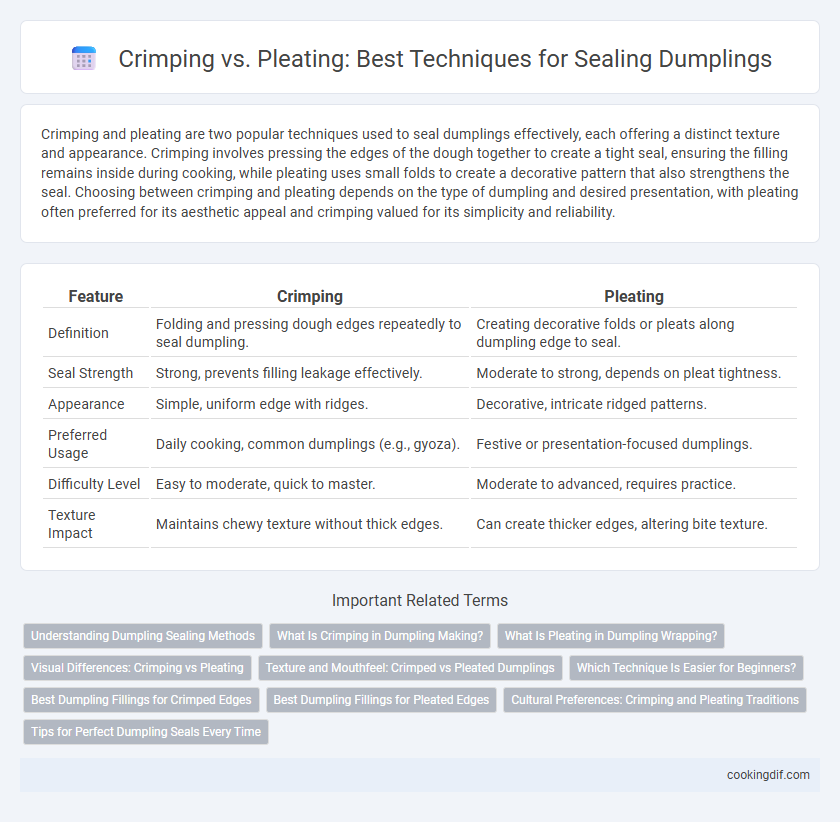Crimping and pleating are two popular techniques used to seal dumplings effectively, each offering a distinct texture and appearance. Crimping involves pressing the edges of the dough together to create a tight seal, ensuring the filling remains inside during cooking, while pleating uses small folds to create a decorative pattern that also strengthens the seal. Choosing between crimping and pleating depends on the type of dumpling and desired presentation, with pleating often preferred for its aesthetic appeal and crimping valued for its simplicity and reliability.
Table of Comparison
| Feature | Crimping | Pleating |
|---|---|---|
| Definition | Folding and pressing dough edges repeatedly to seal dumpling. | Creating decorative folds or pleats along dumpling edge to seal. |
| Seal Strength | Strong, prevents filling leakage effectively. | Moderate to strong, depends on pleat tightness. |
| Appearance | Simple, uniform edge with ridges. | Decorative, intricate ridged patterns. |
| Preferred Usage | Daily cooking, common dumplings (e.g., gyoza). | Festive or presentation-focused dumplings. |
| Difficulty Level | Easy to moderate, quick to master. | Moderate to advanced, requires practice. |
| Texture Impact | Maintains chewy texture without thick edges. | Can create thicker edges, altering bite texture. |
Understanding Dumpling Sealing Methods
Crimping and pleating are essential dumpling sealing methods that ensure the filling stays secure during cooking. Crimping typically involves pinching the edges together to create a tight seal, suitable for thicker wrappers and denser fillings. Pleating forms decorative folds along the dumpling edge, providing a more intricate seal that enhances both appearance and texture while maintaining a strong closure.
What Is Crimping in Dumpling Making?
Crimping in dumpling making involves pinching the edges of the dough together to securely seal the filling, creating a tight bond that prevents leakage during cooking. This technique typically produces a simple, ridged edge, enhancing the dumpling's structural integrity and visual appeal. Crimping is favored for its quick execution and effective sealing, especially in recipes requiring robust closure.
What Is Pleating in Dumpling Wrapping?
Pleating in dumpling wrapping is a technique where the dough edge is folded into small, even pleats that create a decorative and secure seal. This method enhances the dumpling's structural integrity, preventing filling leakage during cooking while adding an appealing texture. Pleating is commonly used in traditional dumplings like Chinese jiaozi and Japanese gyoza, showcasing skilled craftsmanship in dumpling preparation.
Visual Differences: Crimping vs Pleating
Crimping dumpling edges creates a series of tight, consistent folds that result in a scalloped appearance, offering a uniform and sealed edge. Pleating involves folding the dough in larger, overlapping flaps, producing a more pronounced, textured ridge along the dumpling's perimeter. Visually, crimped dumplings appear smoother and more intricate, while pleated dumplings showcase bold, decorative ridges that highlight craftsmanship and style.
Texture and Mouthfeel: Crimped vs Pleated Dumplings
Crimped dumplings create a tighter seal with firm, defined edges offering a chewy texture that contrasts with softer fillings. Pleated dumplings feature delicate, layered folds that enhance flakiness and provide a tender bite alongside the filling's moisture. The choice between crimping and pleating directly impacts the mouthfeel, balancing chewiness and tenderness for distinctive eating experiences.
Which Technique Is Easier for Beginners?
Crimping is generally easier for beginners because it requires simple pinching along the edge of the dumpling wrapper to seal, making it a quicker and less intricate method. Pleating involves creating small folds or pleats along the edge, which demands more practice and precision to achieve a consistent seal. For novice cooks, crimping reduces the risk of dumpling filling leaking during cooking, making it an ideal starting sealing technique.
Best Dumpling Fillings for Crimped Edges
Crimped edges on dumplings create a tight seal that is ideal for juicy and moist fillings such as pork and cabbage or shrimp with garlic chives, preventing leakage during cooking. This sealing technique enhances the texture and presentation of dumplings filled with high-moisture ingredients like mushrooms and tofu, maintaining their shape and flavor. Crimping is best suited for dense, flavorful fillings that benefit from a secure closure to retain juices and aromas.
Best Dumpling Fillings for Pleated Edges
Pleated edges provide a secure seal ideal for juicy dumpling fillings like pork and cabbage, shrimp with garlic chives, or spicy tofu mixtures. The complexity of pleating allows steam to circulate, enhancing flavors while keeping the filling intact. Crimping suits firmer fillings, but pleating is optimal for ingredients that release moisture, ensuring a tender, flavorful bite.
Cultural Preferences: Crimping and Pleating Traditions
Crimping and pleating techniques for dumpling sealing reflect distinct cultural preferences, with crimping commonly seen in Western dumplings such as pierogi and empanadas, while pleating is traditional in Asian varieties like Chinese jiaozi and Japanese gyoza. Crimping involves pressing the dough edges together to create a simple, durable seal, often associated with heartier, baked or fried dumplings typical in European cuisines. Pleating, characterized by intricate folds along the dumpling's edge, not only ensures a tight seal but also highlights artisanal craftsmanship preferred in East Asian culinary traditions.
Tips for Perfect Dumpling Seals Every Time
For perfect dumpling seals every time, mastering crimping and pleating techniques is essential. Crimping involves pinching the edges firmly to create a tight seal, while pleating requires folding the dough systematically to secure the filling and add decorative texture. Use a little water or egg wash on the edges to enhance adhesion and prevent leaks during cooking.
Crimping vs Pleating for dumpling sealing Infographic

 cookingdif.com
cookingdif.com